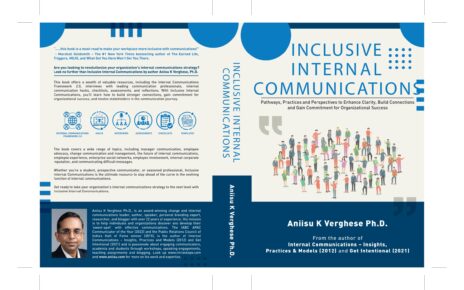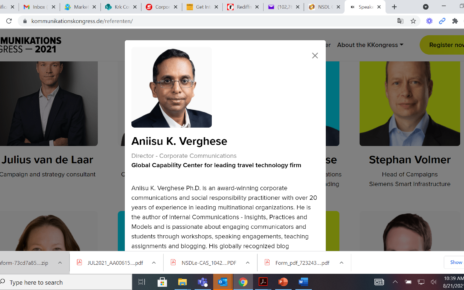- How do you unleash the potential of organizational culture, stakeholder engagement, and leadership alignment?
- What does it take to move the needle with internal communications interventions?
- Are your recommendations just another document awaiting a decision or are they practical and actionable?
I was recently invited by a global telecom major to assess, assimilate and align how internal communications can be improved. The company expected a review of the current state of internal communications, a tactical exercise, and provide recommendations in a workshop. However, I insisted on going deeper and understanding the communication climate and culture better. Through focus groups and a closer look at the channels and content shared, a lot more got uncovered. In this article, I share five strategies that will reframe your approach to internal communication interventions. By leveraging these strategies, you can foster better engagement, alignment, and tangible results.
Effective internal communication interventions are paramount in today’s dynamic business environment. Staying the same isn’t acceptable anymore. To truly make an impact, scratching the surface won’t suffice. As a communication professional and consultant, your role is to dive deep, uncover hidden insights, and ignite transformative change.
To begin, ask yourself these questions:
· How far do stakeholders want to go?
· What do they gain or lose?
· What are their fears and concerns?
· How do they currently communicate?
· What’s the ideal solution and what’s the consensus point?
· What will it take for stakeholders and the internal communications team to let go and work together?
Embrace a Holistic Assessment Approach
To drive effective internal communication, you must grasp the intricate fabric of the stakeholders and organization. Move beyond surface-level assessments and immerse yourself in the organizational culture. Engage with key stakeholders and gain a profound understanding of their challenges, aspirations, and values. What are the key issues bothering staff – information overload? Inconsistent communications? Lack of transparency? Inadequate messages? By embracing a holistic assessment approach, you will be able to pinpoint the core issues and tailor interventions that resonate at a fundamental level, fostering lasting change.
Inspire Genuine Stakeholder Engagement
Effective internal communication goes beyond one-way dissemination of information. It isn’t just about what the communications team believes is important. It needs to be focused on how staff can do their job better each day. Encourage genuine stakeholder engagement by actively seeking their perspectives and inviting them to participate in the communication process. Create platforms for dialogue, feedback, and collaboration, and revisit if the platforms aren’t serving the purpose. Tough calls need to be taken. By empowering stakeholders to be active contributors, you unlock their creativity, insights, and commitment, leading to a stronger and more inclusive communication ecosystem.
Bridge the Gap between Leadership and Employees
Strong leadership communication is the lifeblood of successful internal communication. As a consultant or an in-house communication professional, you play a pivotal role in bridging the gap between leadership and employees. Advocate for transparent, authentic, and two-way communication channels. Staff wants leaders to walk the talk. And be visible. Not sit in their ivory towers and preach values and commitment. Encourage leaders to actively listen, empathize, and engage with their teams. By fostering a culture of open communication and mutual respect, you create an environment where employees feel valued, heard, and motivated.
Craft Actionable Recommendations
Your role is to provide valuable external expertise and propose actionable recommendations. Bring in perspectives from the outside that can be eye-opening and game-changing. Share why internal communications matter and provide insights from industry trends. Challenge the status quo and identify innovative strategies to address communication gaps. Tailor your recommendations to the unique needs of the organization, considering its culture, challenges, and goals. By providing concrete and achievable recommendations, you empower stakeholders to embrace change and drive the transformational journey.
Drive Sustainable Change through Collaborative Action Planning
The communications team can’t do it alone. Unless you have all stakeholders bought into the plan and approach, there is little hope of success. Lasting change requires collective commitment and a well-defined action plan. Conduct collaborative action planning workshops that bring together stakeholders from different levels and functions. Foster open dialogue, align priorities, and establish a shared vision for internal communication. Leverage technology tools that facilitate transparency, accountability, and progress tracking. By fostering a collaborative mindset and providing the necessary resources, you set the stage for sustainable change and continuous improvement.
Mastering internal communication interventions is an essential skill for consultants seeking to make a lasting impact. By embracing a holistic assessment approach, igniting genuine stakeholder engagement, bridging the leadership-employee gap, crafting actionable recommendations, and driving sustainable change through collaborative action planning, you unlock the full potential of internal communication.
Try these strategies to reshape the communication landscape within organizations you work with, fostering a culture of connectivity, productivity, and shared success, and let me know.
Like the article? Subscribe to my newsletter and join close to 6000 Linkedin followers who gain insights every week. Do share your comments as well.


